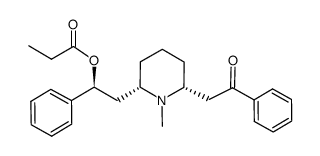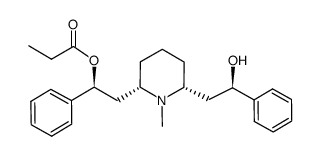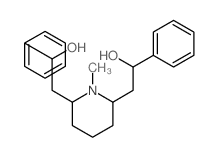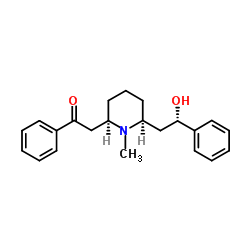134-63-4
| 中文名 | 盐酸山梗碱 |
|---|---|
| 英文名 | α-Lobeline Hydrochcloride |
| 中文别名 |
盐酸洛贝林
2-[1-甲基-6-(beta-羟基苯乙基)-2-哌啶基]苯乙酮盐酸盐 山梗烷醇酮盐酸盐 盐酸-L-山梗碱 |
| 英文别名 |
Ethanone, 2-[(2R,6S)-6-[(2S)-2-hydroxy-2-phenylethyl]-1-methyl-2-piperidinyl]-1-phenyl-, hydrochloride (1:1)
2-[6-(2-Hydroxy-2-phenylethyl)-1-methyl-2-piperidinyl]-1-phenylethanone hydrochloride (1:1) Lobelin hydrochloride Lobeline hydrochloride EINECS 205-150-2 2-{(2R,6S)-6-[(2S)-2-Hydroxy-2-phenylethyl]-1-methyl-2-piperidinyl}-1-phenylethanone hydrochloride 2-{(2R,6S)-6-[(2S)-2-Hydroxy-2-phenylethyl]-1-methyl-2-piperidinyl}-1-phenylethanone hydrochloride (1:1) MFCD00082455 Ethanone, 2-((2R,6S)-6-((2S)-2-hydroxy-2-phenylethyl)-1-methyl-2-piperidinyl)-1-phenyl-, hydrochloride Ethanone, 2-[6-(2-hydroxy-2-phenylethyl)-1-methyl-2-piperidinyl]-1-phenyl-, hydrochloride (1:1) 2-{(2R,6S)-6-[(2S)-2-Hydroxy-2-phenylethyl]-1-methylpiperidin-2-yl}-1-phenylethanone hydrochloride (1:1) 2-{(2R,6S)-6-[(2S)-2-Hydroxy-2-phenylethyl]-1-methyl-2-piperidinyl}-1-phenylethanonhydrochlorid α-Lobeline hydrochloride (-)-Lobeline hydrochloride 2-{(2R,6S)-6-[(2S)-2-Hydroxy-2-phényléthyl]-1-méthyl-2-pipéridinyl}-1-phényléthanone chlorhydrate 2-(6-(2-Hydroxy-2-phenylethyl)-1-methylpiperidin-2-yl)-1-phenylethanone hydrochloride Lobeline (hydrochloride) |
| 描述 | Lobeline盐酸盐是烟碱样受体激动剂, 作为有效的神经元烟碱受体α3β2和α4β2拮抗剂。 |
|---|---|
| 相关类别 |
| 沸点 | 485.6ºC at 760mmHg |
|---|---|
| 熔点 | 183-185 °C (dec.)(lit.) |
| 分子式 | C22H28ClNO2 |
| 分子量 | 373.916 |
| 闪点 | 247.5ºC |
| 精确质量 | 373.180847 |
| PSA | 40.54000 |
| LogP | 4.97590 |
| 外观性状 | 白色至灰白色固体 |
| 蒸汽压 | 3.02E-11mmHg at 25°C |
| 折射率 | -57.5 ° (C=1, H2O) |
| 储存条件 | 保持贮藏器密封、储存在阴凉、干燥的地方,确保工作间有良好的通风或排气装置 |
| 稳定性 | 如果遵照规格使用和储存则不会分解,未有已知危险反应 |
| 水溶解性 | H2O: 25 mg/mL |
| 分子结构 | 1、摩尔折射率:无可用的 2、摩尔体积(cm3/mol):无可用的 3、等张比容(90.2K):无可用的 4、表面张力(dyne/cm):无可用的 5、介电常数:无可用的 6、极化率(10-24cm3):无可用的 7、单一同位素质量:373.180857 Da 8、标称质量:373 Da 9、平均质量:373.9162 Da |
| 计算化学 | 1、 疏水参数计算参考值(XlogP): 2、 氢键供体数量:2 3、 氢键受体数量:3 4、 可旋转化学键数量:6 5、 互变异构体数量:2 6、 拓扑分子极性表面积(TPSA):40.5 7、 重原子数量:26 8、 表面电荷:0 9、 复杂度:412 10、 同位素原子数量:0 11、 确定原子立构中心数量:3 12、 不确定原子立构中心数量:0 13、 确定化学键立构中心数量:0 14、 不确定化学键立构中心数量:0 15、 共价键单元数量:2 |
| 更多 | 1. 性状:白色或黄白色粉末 2. 密度(g/mL,25℃):未确定 3. 相对蒸汽密度(g/mL,空气=1):未确定 4. 熔点(ºC):183-185 5. 沸点(ºC,常压):未确定 6. 沸点(ºC,0.4KPa):未确定 7. 折射率(C=1,H2O):-57.5 º 8. 闪点(ºC):未确定 9. 比旋光度(º):未确定 10. 自燃点或引燃温度(ºC):未确定 11. 蒸气压(mmHg,25ºC):未确定 12. 饱和蒸气压(kPa,20ºC):未确定 13. 燃烧热(KJ/mol):未确定 14. 临界温度(ºC):未确定 15. 临界压力(KPa):未确定 16. 油水(辛醇/水)分配系数的对数值:未确定 17. 爆炸上限(%,V/V):未确定 18. 爆炸下限(%,V/V):未确定 19. 溶解性:水:0.25mg/ml |
|
Section I.Chemical Product and Company Identification Chemical Name Lobeline Hydrochloride Portland OR SynonymNot available. C22H27NO2•HCl Chemical Formula 134-63-4
CAS Number Section II.Composition and Information on Ingredients Toxicology Data Chemical NameCAS Number Percent (%)TLV/PEL Lobeline Hydrochloride134-63-4Min. 98.0 Not available.Mouse LD50 (intraperitoneal) 39900 (HPLC,T)ug/kg Mouse LD50 (intravenous) 7800 ug/kg Mouse LD50 (subcutaneous) 87500 ug/kg Section III. Hazards Identification Acute Health EffectsToxic if ingested or inhaled. Avoid prolonged contact with this material. Overexposure may result in serious illness or death. Follow safe industrial hygiene practices and always wear proper protective equipment when handling this compound. Chronic Health EffectsCARCINOGENIC EFFECTS : Not available. MUTAGENIC EFFECTS : Not available. TERATOGENIC EFFECTS : Not available. DEVELOPMENTAL TOXICITY: Not available. Repeated exposure to an highly toxic material may produce general deterioration of health by an accumulation in one or many human organs. Section IV.First Aid Measures Eye ContactCheck for and remove any contact lenses. In case of contact, immediately flush eyes with plenty of water for at least 15 minutes. Get medical attention. Skin ContactIn case of contact, immediately flush skin with plenty of water for at least 15 minutes while removing contaminated clothing and shoes. Wash clothing before reuse. Thoroughly clean shoes before reuse. Get medical attention immediately. If the victim is not breathing, perform mouth-to-mouth resuscitation. Loosen tight clothing such as a collar, tie, belt or Inhalation waistband. If breathing is difficult, oxygen can be administered. Seek medical attention if respiration problems do not improve. INDUCE VOMITING by sticking finger in throat. Lower the head so that the vomit will not reenter the mouth and throat. Ingestion Loosen tight clothing such as a collar, tie, belt or waistband. If the victim is not breathing, perform mouth-to-mouth resuscitation. Examine the lips and mouth to ascertain whether the tissues are damaged, a possible indication that the toxic material was ingested; the absence of such signs, however, is not conclusive. Section V.Fire and Explosion Data Not available. May be combustible at high temperature.Auto-Ignition Flammability Flash PointsFlammable LimitsNot available. Not available. These products are toxic carbon oxides (CO, CO2), nitrogen oxides (NO, NO2), halogenated compounds. Combustion Products WARNING: Highly toxic HCl gas is produced during combustion. Fire Hazards Not available. Explosion HazardsRisks of explosion of the product in presence of mechanical impact: Not available. Risks of explosion of the product in presence of static discharge: Not available. Fire Fighting Media SMALL FIRE: Use DRY chemical powder. LARGE FIRE: Use water spray, fog or foam. DO NOT use water jet. and Instructions Consult with local fire authorities before attempting large scale fire-fighting operations. Continued on Next Page Lobeline Hydrochloride Section VI.Accidental Release Measures Spill CleanupToxic material. Stop leak if without risk. DO NOT get water inside container. DO NOT touch spilled material. Use water spray to reduce Instructions vapors. Prevent entry into sewers, basements or confined areas; dike if needed. Eliminate all sources of ignition. Consult federal, state, and/or local authorities for assistance on disposal. Section VII. Handling and Storage TOXIC. Keep locked up.. Keep away from heat. Mechanical exhaust required. When not in use, tightly seal the container Handling and Storage and store in a dry, cool place. Avoid excessive heat and light. DO NOT ingest. Do not breathe dust. Wear suitable Information protective clothing. If ingested, seek medical advice immediately and show the container or the label. Treat symptomatically and supportively. Section VIII. Exposure Controls/Personal Protection Use process enclosures, local exhaust ventilation, or other engineering controls to keep airborne levels below recommended Engineering Controls exposure limits. If user operations generate dust, fume or mist, use ventilation to keep exposure to airborne contaminants below the exposure limit. Splash goggles. Lab coat. Dust respirator. Boots. Gloves. A MSHA/NIOSH approved respirator must be used to avoid Personal Protection inhalation of the product. Suggested protective clothing might not be sufficient; consult a specialist BEFORE handling this product. Exposure LimitsNot available. Section IX. Physical and Chemical Properties Solid. (White powder.)Solubility Physical state @ 20°CSoluble in water, alcohol. Very soluble in chloroform. Not available.Very slightly soluble in ether. Specific Gravity 373.92 Molecular WeightPartition CoefficientNot available. Boiling PointNot available.Vapor PressureNot applicable. 180°C (356°F)Not available. Melting PointVapor Density Not available.VolatilityNot available. Refractive Index Not available. Critical TemperatureNot available.Odor ViscosityNot available.TasteNot available. Section X.Stability and Reactivity Data Stability This material is stable if stored under proper conditions. (See Section VII for instructions) Conditions of InstabilityAvoid excessive heat and light. Incompatibilities Reactive with strong oxidizing agents. Section XI. Toxicological Information OJ8490100 RTECS Number Routes of ExposureEye Contact. Ingestion. Inhalation. Mouse LD50 (intraperitoneal) 39900 ug/kg Toxicity Data Mouse LD50 (intravenous) 7800 ug/kg Mouse LD50 (subcutaneous) 87500 ug/kg Chronic Toxic EffectsCARCINOGENIC EFFECTS : Not available. MUTAGENIC EFFECTS : Not available. TERATOGENIC EFFECTS : Not available. DEVELOPMENTAL TOXICITY: Not available. Repeated exposure to an highly toxic material may produce general deterioration of health by an accumulation in one or many human organs. Acute Toxic EffectsToxic if ingested or inhaled. Avoid prolonged contact with this material. Overexposure may result in serious illness or death. Follow safe industrial hygiene practices and always wear proper protective equipment when handling this compound. Continued on Next Page Lobeline Hydrochloride Section XII.Ecological Information EcotoxicityNot available. Not available. Environmental Fate Section XIII. Disposal Considerations Recycle to process, if possible. Consult your local regional authorities. You may be able to dissolve or mix material with a Waste Disposal combustible solvent and burn in a chemical incinerator equipped with an afterburner and scrubber system. Observe all federal, state and local regulations when disposing of the substance. Section XIV. Transport Information DOT ClassificationDOT CLASS 6.1: Toxic material. PIN Number Proper Shipping NameAlkaloids, solid, n.o.s. III Packing Group (PG) DOT Pictograms Section XV. Other Regulatory Information and Pictograms TSCA Chemical InventoryThis product is NOT on the EPA Toxic Substances Control Act (TSCA) inventory. The following notices are required by 40 CFR 720.36 (C) for those products not on the inventory list: (EPA) (i) These products are supplied solely for use in research and development by or under the supervision of a technically qualified individual as defined in 40 CFR 720.0 et sec. (ii) The health risks of these products have not been fully determined. Any information that is or becomes available will be supplied on an MSDS sheet. WHMIS ClassificationCLASS D-1B: Material causing immediate and serious toxic effects (TOXIC). (Canada) EINECS Number (EEC) 205-150-2 EEC Risk StatementsR23/24/25- Toxic by inhalation, in contact with skin and if swallowed. SECTION 16 - ADDITIONAL INFORMATION N/A |
|
毒理学数据: 1、 急性毒性:小鼠腹腔LD50:39900μg/kg 小鼠皮下LD50:87500μg/kg 小鼠静脉注射LD50:7800μg/kg 青蛙肠外LDLo:150mg/kg 生态学数据: 根据国家和地方有关法规的要求处置。或与厂商或制造商联系,确定处置方法。 CHEMICAL IDENTIFICATION
HEALTH HAZARD DATAACUTE TOXICITY DATA
|
| 符号 |

GHS06 |
|---|---|
| 信号词 | Danger |
| 危害声明 | H301 + H331 |
| 警示性声明 | P261-P301 + P310-P311 |
| 个人防护装备 | Eyeshields;Faceshields;Gloves;type P2 (EN 143) respirator cartridges |
| 危害码 (欧洲) | T:Toxic; |
| 风险声明 (欧洲) | R23/25 |
| 安全声明 (欧洲) | S36/37/39-S45 |
| 危险品运输编码 | UN 1544 6.1/PG 3 |
| WGK德国 | 3 |
| RTECS号 | OJ8490100 |
| 包装等级 | III |
| 危险类别 | 6.1(b) |
|
~% 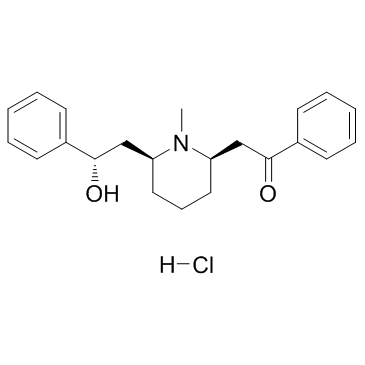
134-63-4 |
| 文献:Journal of the American Chemical Society, , vol. 130, # 41 p. 13745 - 13754 |
|
~% 
134-63-4 |
| 文献:Organic Letters, , vol. 9, # 17 p. 3237 - 3240 |
|
~% 
134-63-4 |
| 文献:Organic Letters, , vol. 9, # 17 p. 3237 - 3240 |
|
~% 
134-63-4 |
| 文献:Organic Letters, , vol. 9, # 17 p. 3237 - 3240 |
|
~% 
134-63-4 |
| 文献:Organic Letters, , vol. 9, # 17 p. 3237 - 3240 |
| 上游产品 3 | |
|---|---|
| 下游产品 2 | |



